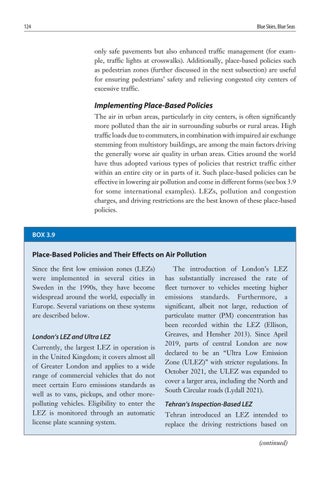124
Blue Skies, Blue Seas
only safe pavements but also enhanced traffic management (for example, traffic lights at crosswalks). Additionally, place-based policies such as pedestrian zones (further discussed in the next subsection) are useful for ensuring pedestrians’ safety and relieving congested city centers of excessive traffic.
Implementing Place-Based Policies The air in urban areas, particularly in city centers, is often significantly more polluted than the air in surrounding suburbs or rural areas. High traffic loads due to commuters, in combination with impaired air exchange stemming from multistory buildings, are among the main factors driving the generally worse air quality in urban areas. Cities around the world have thus adopted various types of policies that restrict traffic either within an entire city or in parts of it. Such place-based policies can be effective in lowering air pollution and come in different forms (see box 3.9 for some international examples). LEZs, pollution and congestion charges, and driving restrictions are the best known of these place-based policies.
BOX 3.9
Place-Based Policies and Their Effects on Air Pollution Since the first low emission zones (LEZs) were implemented in several cities in Sweden in the 1990s, they have become widespread around the world, especially in Europe. Several variations on these systems are described below.
London’s LEZ and Ultra LEZ Currently, the largest LEZ in operation is in the United Kingdom; it covers almost all of Greater London and applies to a wide range of commercial vehicles that do not meet certain Euro emissions standards as well as to vans, pickups, and other morepolluting vehicles. Eligibility to enter the LEZ is monitored through an automatic license plate scanning system.
The introduction of London’s LEZ has substantially increased the rate of fleet turnover to vehicles meeting higher emissions standards. Furthermore, a significant, albeit not large, reduction of particulate matter (PM) concentration has been recorded within the LEZ (Ellison, Greaves, and Hensher 2013). Since April 2019, parts of central London are now declared to be an “Ultra Low Emission Zone (ULEZ)” with stricter regulations. In October 2021, the ULEZ was expanded to cover a larger area, including the North and South Circular roads (Lydall 2021).
Tehran’s Inspection-Based LEZ Tehran introduced an LEZ intended to replace the driving restrictions based on (continued)






